
Flappers were a subculture of young Western women prominent after the First World War and through the 1920s who wore short skirts, bobbed their hair, listened to jazz, and flaunted their disdain for prevailing codes of decent behavior. Flappers were seen as brash for wearing excessive makeup, drinking alcohol, smoking cigarettes in public, driving automobiles, treating sex in a casual manner, and otherwise flouting social and sexual norms. As automobiles became more available, flappers gained freedom of movement and privacy.

Blondie is an American comic strip created by cartoonist Chic Young. The comic strip is distributed by King Features Syndicate, and has been published in newspapers since September 8, 1930. The success of the strip, which features the eponymous blonde and her sandwich-loving husband, led to the long-running Blondie film series (1938–1950) and the popular Blondie radio program (1939–1950).
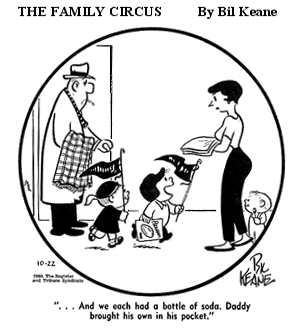
The Family Circus is a syndicated comic strip created by cartoonist Bil Keane and, since Keane's death in 2011, is written, inked and rendered (colored) by his son Jeff Keane. The strip generally uses a single captioned panel with a round border, hence the original name of the series, which was changed following objections from the magazine Family Circle. The series debuted February 29, 1960 and has been in continuous production ever since. According to publisher King Features Syndicate, it is the most widely syndicated cartoon panel in the world, appearing in 1,500 newspapers. Compilations of Family Circus comic strips have sold more than 13 million copies worldwide.

Murat Bernard "Chic" Young was an American cartoonist who created the comic strip Blondie. His 1919 William McKinley High School Yearbook cites his nickname as Chicken, source of his familiar pen name and signature. According to King Features Syndicate, Young had a daily readership of 52 million. Stan Drake, who drew Blondie in the 1980s and 1990s, stated that Young "has to go down in history as one of the geniuses of the industry."

Milton Arthur Paul Caniff was an American cartoonist known for the Terry and the Pirates and Steve Canyon comic strips.

Dagwood Bumstead is a main character in cartoonist Chic Young's long-running comic strip Blondie. He debuted in the first strip on September 8, 1930.
See also: 1920s in comics, other events of the 1930s, 1940s in comics and the list of years in comics
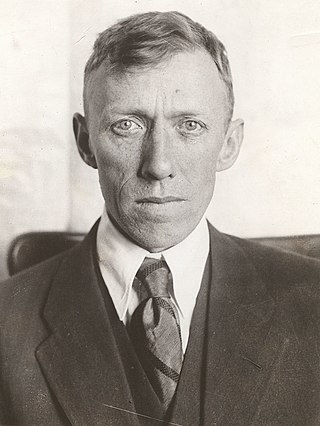
Thomas Aloysius "Tad" Dorgan was an Irish American cartoonist. He is known for his cartoon panel Indoor Sports and comic strip Judge Rummy, as well as the many English words and expressions he coined or popularized.

Boob McNutt was a comic strip by Rube Goldberg which ran from June 9, 1918 to September 23, 1934. It was syndicated by the McNaught Syndicate from 1922 until the end of its run.

The Newspaper Enterprise Association (NEA) is an editorial column and comic strip newspaper syndication service based in the United States and established in 1902. The oldest syndicate still in operation, the NEA was originally a secondary news service to the Scripps Howard News Service; it later evolved into a general syndicate best known for syndicating the comic strips Alley Oop, Our Boarding House, Freckles and His Friends, The Born Loser, Frank and Ernest, and Captain Easy / Wash Tubbs; in addition to an annual Christmas comic strip. Along with United Feature Syndicate, the NEA was part of United Media from 1978 to 2011, and is now a division of Andrews McMeel Syndication. The NEA once selected college All-America teams, and presented awards in professional football and professional [NBA] basketball.
Ace Comics was a comic book series published by David McKay Publications between 1937 and 1949 — starting just before the Golden Age of Comic Books. The title reprinted syndicated newspaper strips owned by King Features Syndicate, following the successful formula of a mix of adventure and humor strips introduced by McKay in their King Comics title in April 1936; some of the strips were transferred from King Comics and continued in Ace Comics from issue #1. Ace Comics #11, the first appearance of The Phantom, is regarded by many to be a key issue in the history of comics, as it introduced to the comics format one of the first of the costumed heroes, leading to the Golden Age of superheroes in comics.

Russell Patterson was an American cartoonist, illustrator and scenic designer. Patterson's art deco magazine illustrations helped develop and promote the idea of the 1920s and 1930s fashion style known as the flapper.
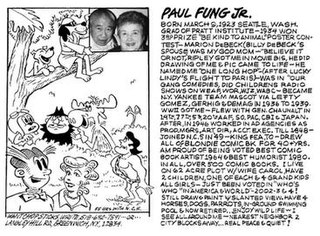
Paul Fung Jr. was an American cartoonist who drew the Blondie comic book for 40 years. He was the son of Paul Fung, a cartoonist who drew the comic strip Dumb Dora for several years.
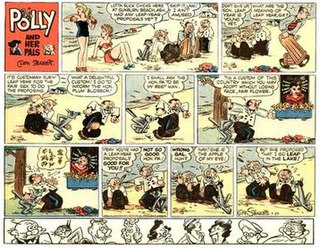
Polly and Her Pals is an American comic strip, created by cartoonist Cliff Sterrett, which ran from December 4, 1912, until December 7, 1958. It is regarded as one of the most graphically innovative strips of the 20th century. It debuted as Positive Polly on December 4, 1912, in William Randolph Hearst's newspapers, initially the New York Journal, and was later distributed by King Features Syndicate. The title changed to Polly and Her Pals on January 17, 1913.
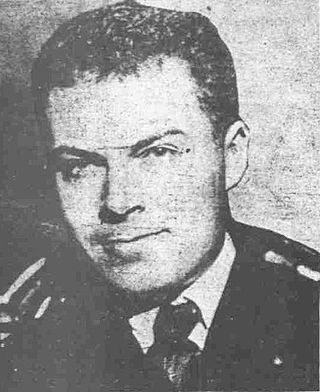
Clifford Sterrett was an American cartoonist best known as the creator of the comic strip Polly and Her Pals.

Freckles and his Friends is an American comic strip set in the peaceful small town of Shadyside where young Freckles McGoosey and his friends lived. Although the long-running strip, created by Merrill Blosser, is remembered for its continuing storyline involving a group of teenagers, it originally featured a child at the age of six or seven in gag-a-day situations.

Paul Fung (1897–1944) was an American cartoonist best known for the comic strip Dumb Dora.

John Thomas "Jack" Callahan, was a noted cartoonist during the early decades of the 20th century, being also credited for drawing the diagram for the first American crossword.

Muggs and Skeeter was an American gag-a-day daily comic strip by Wally Bishop which ran from 1927 to 1974. Originally titled Muggs McGinnis, it was syndicated by the Central Press Association and then King Features Syndicate.
William Raphael Louis Dwyer, Jr., known as Bil Dwyer, was an American cartoonist and humorist. He was known for several newspaper comic strips in the 1930s and 1950s, including Dumb Dora and Sandy Hill, as well as a series of humorous books of Southern slang published in the 1970s.

















